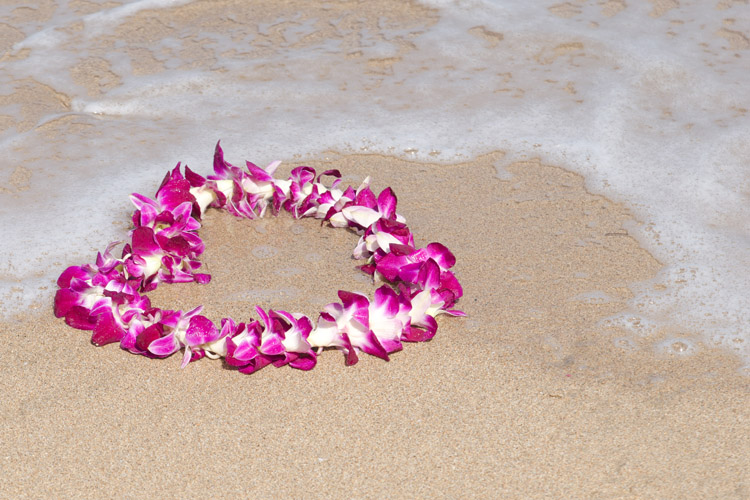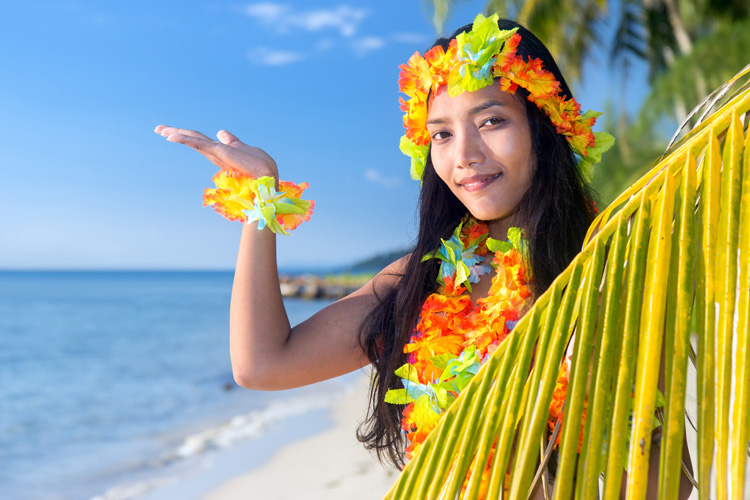Lei is the name of the famous flower necklace made in Hawaii.
Hawaiian leis are vibrant and colorful wreaths or garlands worn around the neck. They feature fresh tropical flowers, but, on a wider interpretation, it can also mean a series of items strung together so that they can be worn.
A lei is presented to someone who is arriving or leaving. Therefore, it is a welcome or farewell gift and a way of expressing aloha.
Leis may include tropical flowers, seeds, leaves, vines, feathers, shells, nuts, and even animal bones and teeth.
Hawaiian flower leis were used by ancient locals to improve their appearance and celebrate the Hawaiian and Polynesian cultures. They are a symbol of hospitality and affection between two people.
The most common Hawaiian leis feature carnations, ginger blossoms, kika blossoms, orchids, or jasmine blossoms.
Leis measure around 18 inches (46 centimeters).

Lei Etiquette
Leis are also used in weddings. Traditionally, Hawaiian brides wear white leis, but they can also include a few colorful flowers.
Closed leis should be worn around the neck, slightly standing on top of the shoulders. The receiver should bow his or her head down and let the giver place the flower garland around his neck.
It is extremely impolite to refuse a lei from someone, even a stranger. It should be an honor to wear it.
Hawaiians also use leis on graduation days. Whenever someone is leaving school or university, he or she receives a graduation lei during the ceremony.
The most popular flowers used in graduation leis are purple, white, and green orchids, as well as pink carnation leis and yellow rose leis.
But there are many kinds of lei - money leis, penny leis, candy leis, double leis, etc.
These stunning floral adornments, alongside the ukulele, are an enduring symbol of Hawaii and can be used for different purposes on multiple occasions.
The Hawaiian language makes no distinction between singular and plural, so the use of the word "leis" is an anglicized version of the original expression "lei."

Types of Lei
The most popular lei styles are the following:
- Haku: flowers, leaves, or fruit are braided onto three strands of ti or other natural fiber. Haku leis are most often worn around the head or on a hat;
- Hili: these are braided leis made from single plant material such as ti leaf or maile;
- Humupapa: flowers are sewn onto plant material such as dried banana leaves (lau hala);
- Kui: the most familiar leis - flowers strung together with needle and thread;
- Kipu'u: short lengths of vines or long-stemmed leaves knotted together;
- Wili: plant materials are attached to a natural backing by winding fiber around them. Will leis have no knots until the very end;
- Lei Hulu (Feather Lei): traditionally made of feathers from now mostly extinct or endangered native birds, the art continues using feathers from common birds;
- Lei Pupu (Shell Lei): these range from puka-shell lei, extremely popular in the 1970s, to museum-quality Ni'ihau-shell lei that may be worth many thousands of dollars;
- Seed Lei: simple, single-stranded Job's tears and intricately crafted wiliwili seed lei are famous examples of this type;
- Contemporary Lei: from silk and ribbon to yarn, currency, and even candy, contemporary lei are made for every occasion.
Make Your Own Hawaiian Lei
Every year, on May 1st, Hawaii celebrates Lei Day.
It is a really special occasion for Hawaiians to make, wear, and give leis and a fantastic opportunity for lei makers to showcase their incredible skills.
But how do you make a fresh Hawaiian lei? Lei-making is an ancient art with intricate techniques, but you can quickly learn how to make a simple lei in a few minutes.
All you need is flowers, a string, a scissor, and a long needle:
- String the flowers: use a needle and double thread to string flowers through the thickest part of the stem;
- Tuck in the previous flower to the next flower;
- Tie a double knot: tie the ends of the thread with a double knot and cut the excess thread;
